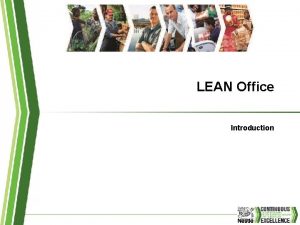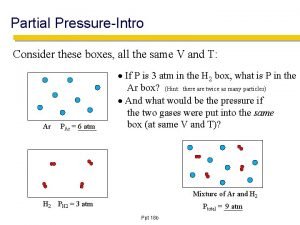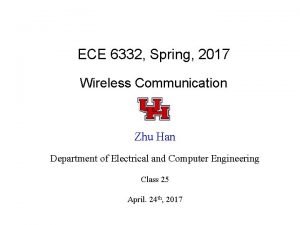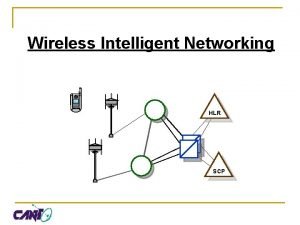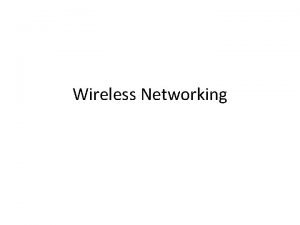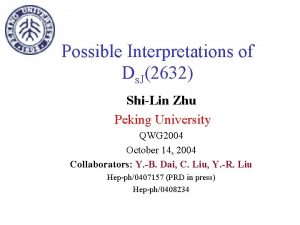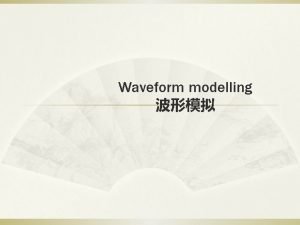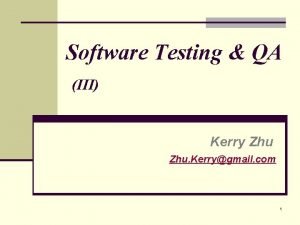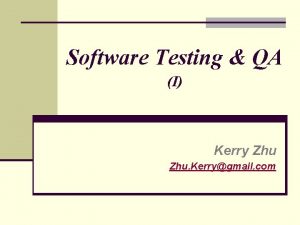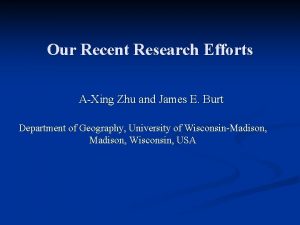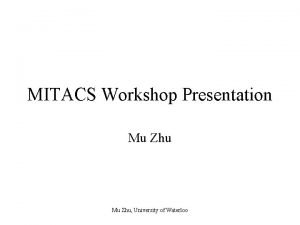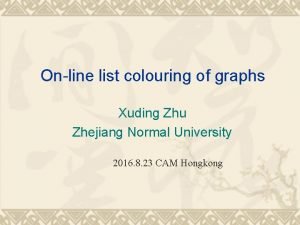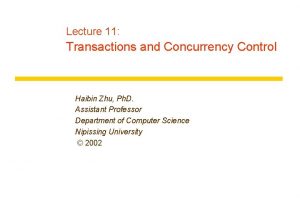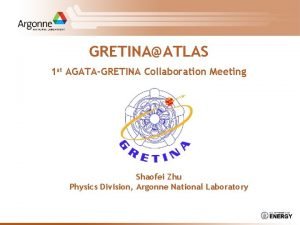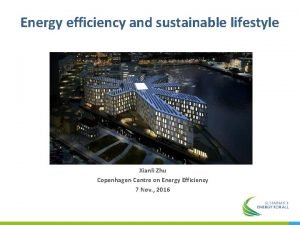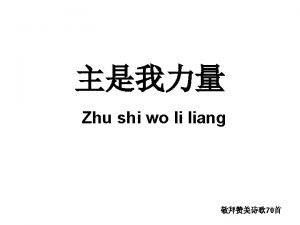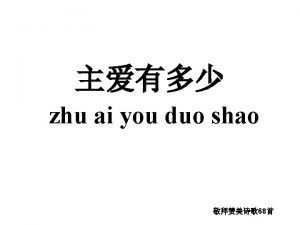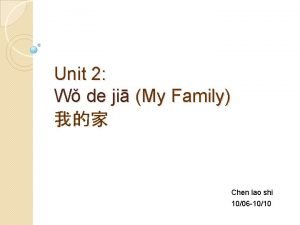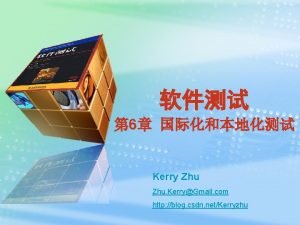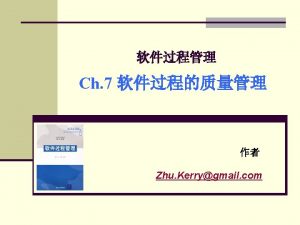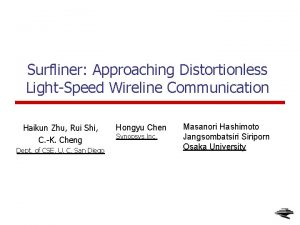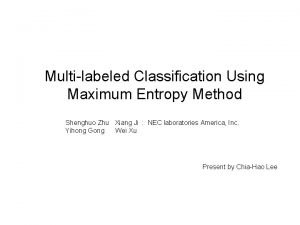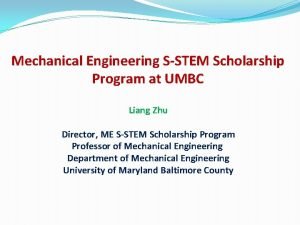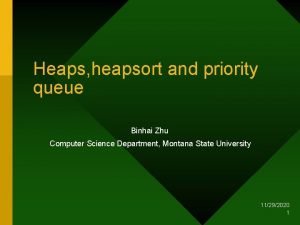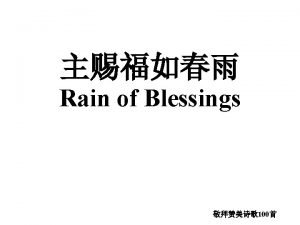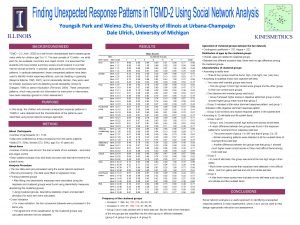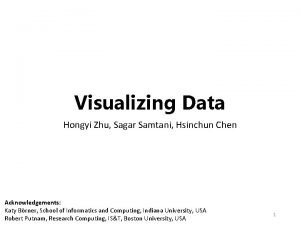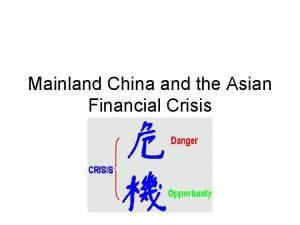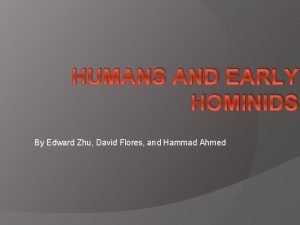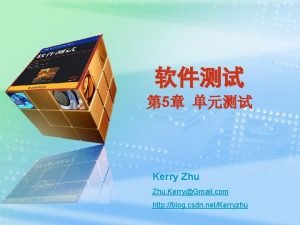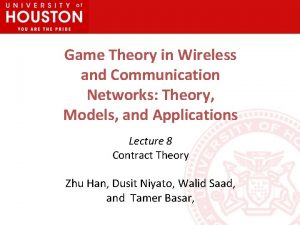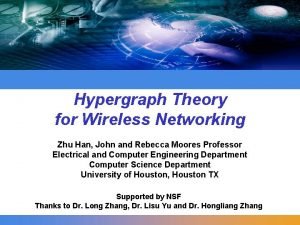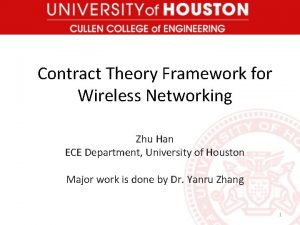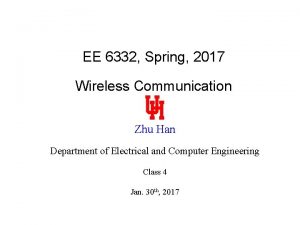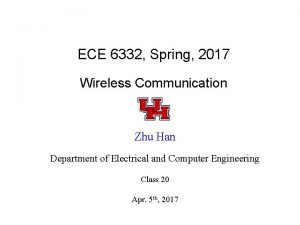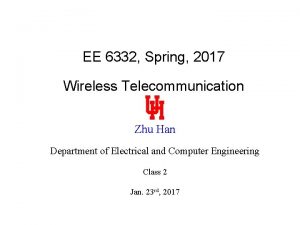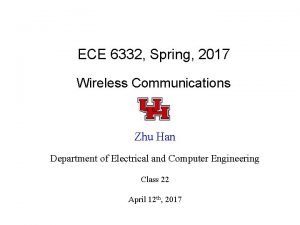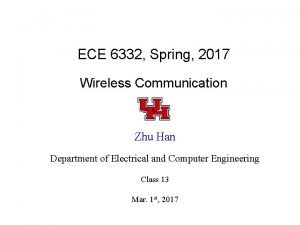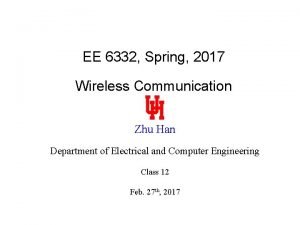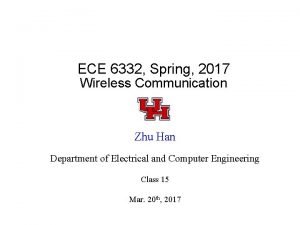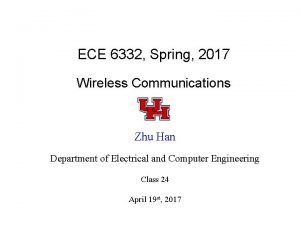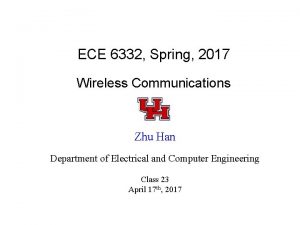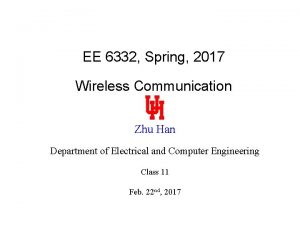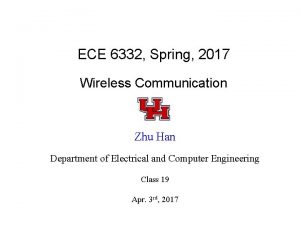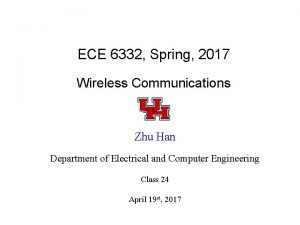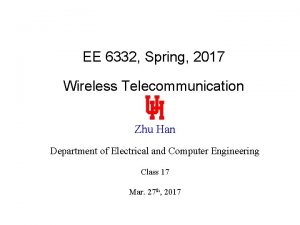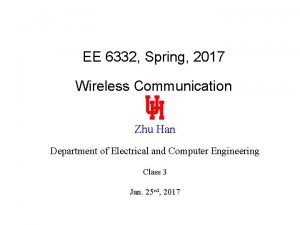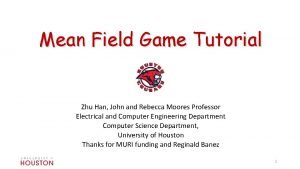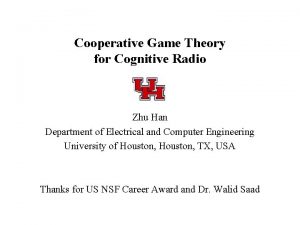Hypergraph Theory for Wireless Networking Zhu Han John





















































- Slides: 53

Hypergraph Theory for Wireless Networking Zhu Han, John and Rebecca Moores Professor Electrical and Computer Engineering Department Computer Science Department University of Houston, Houston TX Supported by NSF Thanks to Dr. Long Zhang, Dr. Lisu Yu and Dr. Hongliang Zhang

Outline 1. Motivation 2. Hypergraph Basics v v 3. Basic concepts Hypergraph coloring Hypergraph matching Hypergraph machine learning Applications v Device-to-Device Communications v Mobile Edge Computing v User-Centric Ultra-Dense Networks 1

Future Wireless Challenge Explosion of data V. S. Limited spectrum Exabytes per Month 2

Possible Solution Ultra-dense Networks, Device-to-Device, etc. § The cumulative interference will be significant § The relations among entities are complicated 3

Motivation Why hypergraph? § Graph is a pairwise relationship, and cannot model the relations among multiple users. § The hyperedges in hypergraph can contain a subset of the vertices, and are suitable to capture the relations among multiple users. § The relations among entities (e. g. , interference) in the future networks are complicated, and thus hypergraph is necessary to model the relations. 4

Outline 1. Motivation 2. Hypergraph Basics v v 3. Basic concepts Hypergraph coloring Hypergraph matching Hypergraph machine learning Applications v Device-to-Device Communications v Mobile Edge Computing v User-Centric Ultra-Dense Networks 5

Definition Hypergraph § Let be a finite set. A hypergraph on of subsets of such that § is called the vertex and is call the hyperedge § Set of hyperedges containing vertex § Cardinality of the edge Incidence Matrix § A matrix with n rows and m columns • Rows: vertices • Columns: hyperedges 6 is a family

Hypergraph Operations Strong deletion of a vertex § A strong deletion of from is to delete all the hyperedges in from , and also delete from. Weak deletion of a vertex § A weak deletion of each hyperedge in from is to only remove . 7 from and

Subhypergraph § Let and be a hypergraph. Hypergraph can be called a subhypergraph of such that. § Hypergraph is called an induced subhypergraph of , and the hyperedges (of completely contained in ) form. if An induced subhypergraph can be obtained by strong deletion of vertices. 8

Transversal and Matching Stable (independent) set § A subset of vertices which contains no hyperedge , e. g. {1, 2, 4, 5} § The largest cardinality of a stable set is called stability number, denoted by Transversal § A set is a transversal if for each § The cardinality of a minimum transversal is Matching § In hypergraph , hyperedges which pairwise have no common vertices are called a matching § A perfect matching is a matching which contains every vertex of a hypergraph. (this example has no perfect matching due to 1) 9 Matching is a stable set:

Outline 1. Motivation 2. Hypergraph Basics v v 3. Basic concepts Hypergraph coloring Hypergraph matching Hypergraph machine learning Applications v Device-to-Device Communications v Mobile Edge Computing v User-Centric Ultra-Dense Networks 10

Introduction Hypergraph coloring § A labeling of the vertex set with the color set § One-to-one assignment Types of hypergraph coloring § Weak coloring § Strong coloring § Uniform coloring Different types of hypergraph coloring § Have different requirements § Can be solved by the same coloring algorithm 11

Coloring Weak coloring (e. g. resource allocation) § Every hyperedge should contain at least 2 colors § : The minimum number of colors needed § Propositions: Weak coloring The cardinality of a color set * stable number. The vertices in the transversal >=|X| is colored differently Strong coloring (e. g. color map) § All the vertices in a hyperedge are colored differently Uniform coloring (e. g. scheduling) § The difference of the numbers of vertices with the same color is always to within 1 12 Strong coloring Uniform coloring

Hypergraph Coloring Algorithm Monodegree § Maximum cardinality of a subfamily § looks like a star, where such that is the center of the star (e. g. 4) Coloring Algorithm § Find an ordering of the vertices according to their monodegrees § The vertices are colored in the reverse order § For each vertex, we use the first available color in the set of colors 13 Subfamily

Hypergraph (Weak) Coloring Algorithm x 1 x 2 x 7 x 6 x 3 x 4 14 x 5

Outline 1. Motivation 2. Hypergraph Basics v v 3. Basic concepts Hypergraph coloring Hypergraph matching Hypergraph machine learning Applications v Device-to-Device Communications v Mobile Edge Computing v User-Centric Ultra-Dense Networks 15

Introduction Hypergraph matching § Find a set of disjoint hyperedges -uniform hypergraph § Each hyperedge has vertices § Special case: -dimensional matching § e. g. project with 3 students It is hard to find the maximum weighted matching for an arbitrary hypergraph § In practice, we consider the -uniform hypergraph § -uniform hypergraph matching problem is also NP-hard for § Local search algorithm 16

Basic Definitions Representative graph § Given hypergraph , the representative graph of § Hyperedges in are vertices in correspond to edges in is the , and intersections of hyperedges -claw § A -claw is defined as a subgraph of connects to independent vertices e 1 3 Hypergraph e 2 5 2 -claw 2 1 e 4 4 whose center vertex e 3 e 5 e 2 Representative graph e 4 6 e 3 17

Hypergraph Matching Algorithm Find an initial matching by some greedy algorithms. Search for a -claw that can improve the overall performance for all § Add the containing talons to the matching § Remove all hyperedges that intersect with them from the matching The above process will be repeated until all the -claws are examined. Representative graph Hypergraph e 1 Talon e 1 3 e 4 4 e 2 2 1 5 e 3 e 5 6 An initial matching e 2 3 18 e 2 2 1 e 4 4 Talon e 3 Center vertex (e. g. 2 -claw) e 1 e 5 e 4 Hypergraph 5 e 3 Add talons 3 e 5 6 e 4 4 e 2 2 1 5 e 3 e 5 6 Remove hyperedges Is new matching better?

Outline 1. Motivation 2. Hypergraph Basics v v 3. Basic concepts Hypergraph coloring Hypergraph matching Hypergraph machine learning Applications v Device-to-Device Communications v Mobile Edge Computing v User-Centric Ultra-Dense Networks 19

Introduction An example § U. S. President Donald Trump pays state visit to China. Trump arrives at Beijing on Nov. 8, 2017. Chinese President Xi Jinping hosts a welcome ceremony for Donald Trump in Beijing, and he says his visit is successful and historic. U. S. President Donald Trump his U. S. President Donald Trump Chinese President Xi Jinping Donald Trump he his 20 Trump Chinese President Xi Jinping he

Problem Definition Problem description § Given the weighted hypergraph § : pairwise weight between any two vertices, derived by § : diagonal matrix with the m-th diagonal element being the sum of elements of the m-th row of § -way normalized cut: Partition the vertex set subsets by solving the following problems: into disjoint overall Similarity n-th column of within cluster Similarity Mixed integer non-convex problem S. X. Yu and J. Shi, “Multiclass Spectral Clustering, ” IEEE Int. Conf. Computer Vision, 2003 21

Clustering Algorithm Approximation § , to indicate the inter-cluster separability § Define , and is an orthogonal matrix § Transformed into a sum-trace-ratio optimization problem: Algorithm § Relax the elements in to be continuous § Compute the trace ratio § Compute the largest eigenvalues of and define their associated eigenvectors as § Recover the optimal discrete solution from the continuous solution 22

Machine Learning Types of Learning Algorithms Supervised Learning u Classification u Regression Unsupervised Learning u Grouping u Clustering Applications: ranking, recommendation systems, visual identity tracking, face verification, and speaker verification. the field of density estimation in statistics, other domains involving summarizing and explaining data features. 23 Reinforcement Learning u Simulation-based Optimization u Genetic Algorithm u Dynamic Programming Applications: used in autonomous vehicles or in learning to play a game against a human opponent.

Clustering (K-means) K=5 24

Outline 1. Motivation 2. Hypergraph Basics v v 3. Basic concepts Hypergraph coloring Hypergraph matching Hypergraph machine learning Applications v Device-to-Device Communications v Mobile Edge Computing v User-Centric Ultra-Dense Networks 25

Introduction Device-to-Device (D 2 D) communications: § Allow mobile users to communicate with each other directly by reusing the cellular radio resources Benefits: § § Improve spectral efficiency Reduce energy consumption Offload cellular data Extend cell coverage H. Zhang, L. Song, and Z. Han, “Radio Resource Allocation for Device-to-Device Underlay Communication Using Hypergraph Theory, ” IEEE Trans. Wireless Commun. , vol. 15, no. 7, pp. 4852 -4861, Jul. 2016. 26

Introduction Challenges: Interference § Inter-tier interference: Interference among D 2 D users § Cross-tier intereference: Interference between cellular and D 2 D users Solution: § Proper resource assignment § Efficient interference management 27

System Model An uplink scenario Two types of users § Cellular user: orthogonal access § D 2 D user: underlay of cellular communications § A D 2 D/cellular user can utilize at most one channel Transmit power: fixed Interference § Cellular user -> D 2 D receiver § D 2 D transmitter -> base station and other D 2 D receivers 28

Problem Formulation Objective § Maximize the system sum-rate by optimizing channel allocation for cellular and D 2 D users Optimization problem Channel allocation for cellular users Channel allocation for D 2 D users A channel can be allocated to at most one cellular user A D 2 D/cellular user can utilize at most one channel 29

Hypergraph Formulation Combinatorial optimization problem § NP-hard § Graph coloring is an approximate and efficient method for such a resource allocation problem § To model the accumulative interference from multiple D 2 D users, hypergraph model is adopted Hypergraph model § Channels: different colors § Cellular/D 2 D users: vertices § Interference relations: hyperedges 30

Hypergraph Construction Independent interferers recognition § Pairwise comparison § Wanted signal ratio to the interference is below a threshold § Each user and its independent interferers will form edges Cumulative interferers recognition § Independent interferers will not be cumulative interferers § Wanted signal to the cumulative interference ratio is below a threshold § Each user and its cumulative interferers will form hyperedges Solution § Weak coloring (two channel/color) § The number of colors may not be sufficient: select a color randomly 31

Simulation Results Hypergraph based scheme can achieve a higher data rate than the graph based one The outage probability for D 2 D users obtained by the hypergraph scheme is lower 32

Brief Summary D 2 D underlay communications § Since multiple D 2 D users can share the same channel, the cumulative interference might be severe § Hypergraph is adopted to model the cumulative interference • D 2 D/cellular users: vertices • Channels: colors • Interference relations: hyperedges § Hypergraph coloring is an efficient method to allocate the resources 33

Outline 1. Motivation 2. Hypergraph Basics v v 3. Basic concepts Hypergraph coloring Hypergraph matching Hypergraph machine learning Applications v Device-to-Device Communications v Mobile Edge Computing v User-Centric Ultra-Dense Networks 34

Introduction Mobile edge computing (MEC) has potentials to bring multiple benefits by extending computation and storage resources to the network edge. Network Functions Virtualization (NFV) can virtualize network services and functions as multiple virtual machines (VMs) on top of commoditized physical machines (PMs). To implement the NFV-enabled MEC architecture, virtual network functions (e. g. , virtualized computing and storage services) are deployed at the MEC data center by creating VM instances simultaneously running on PMs. One important challenge lies in how to efficiently achieve the VM placement on top of the PMs and allocate the virtualized resources to the UEs satisfying the requirement of workloads. 35

Motivation VM placement problem in existing works was formulated bearing in mind an obvious technique constraint that a single VM instance must be running on one PM. For example, VM monitor software known as hypervisor cannot support the creation of one single VM instance that spans multiple PMs. However, the cutting-edge v. SMP hypervisor from Scale. MP can aggregate multiple PMs into a single highly capable VM. Our work intends to achieve an energy efficient VM placement by characterizing much more complex mapping relation between VM instances and PMs, which involves the VM placement across several PMs. 36

System Model (1/2) One MEC system consisting of one e. NB integrated with a MEC data center and L UEs. The MEC data center: M PMs to provide physical resources, i. e. , processor cores and memory sizes: N VM instances running on M PMs: PMs Available resource vector: VM instances Resource shape vector: UEs Resource requirement vector: 37

System Model (2/2) We adopt a partial computation offloading model, and also derive the energy consumption during the following three stages: Local Computing Computation Offloading Energy consumption per processor cycle for local computing Maximum transmit power of UE Transmit power of UE Computing at MEC data center Energy consumption per processor cycle for computing at VM instance 38 Total energy consumption of the MEC system for computing and offloading during time duration T:

Problem Formulation Our objective is to minimize the total energy consumption for computing and offloading, aiming to obtain the optimal VM placement: N×M 0 -1 VM placement matrix Virtualized resources of VM instance vi can be placed across at most d PMs PM pj can host at most δ VM instances Constraints of number of processor cores and amount of memory sizes Binary variable to indicate whether VM instance vi is placed on PM pj 39

Hypergraph Construction (1/2) We construct the weighted hypergraph model based on the complex placement relation between VM instances and PMs: Complex Placement Relation Virtualized resources of VM instance vi can be placed across at most d PMs PM pj can host at most δ VM instances transformation Incidence Matrix 40

Hypergraph Construction (2/2) Weighted hypergraph model: Vertex VM instance PM Hyperedge weight accumulated energy consumption for computing in a hyperedge transformation Our target for the energy consumption minimization problem is to find an (M*)-perfect matching as a collection of M* vertex-disjoint hyperedges with the maximum total weight by covering as many vertices as possible in. 41

Hypergraph Matching Algorithm Design For a generalized hypergraph matching problem, seeking a maximumweight subset of vertex-disjoint hyperedges is NP hard. We use local search to find a suboptimal solution. 1 Construct Representative graph every vertex of every hyperedge of 2 Search for φ-claw An initial matching {p 2, p 4} Updated matching {p 3, p 6} Better? 42

Brief Summary We formulate the energy consumption minimization problem as an intractable 0 -1 integer linear programming problem with an uncertain number of PMs and unknown linear summation constraints. We transform the optimization problem into a non-uniform weighted hypergraph model. The energy efficient VM placement is converted to find a maximumweight hypergraph matching. We propose a hypergraph matching algorithm via local search to seek a maximum-weight subset of vertex-disjoint hyperedges. 43

Outline 1. Motivation 2. Hypergraph Basics v v 3. Basic concepts Hypergraph coloring Hypergraph matching Hypergraph machine learning Applications v Device-to-Device Communications v Mobile Edge Computing v User-Centric Ultra-Dense Networks 44

System Model Sparse code multiple access (SCMA) Fig. An example of codebook allocation based system model in user-centric ultra-dense networks. 45

Problem Formulation Codebook set Ensure the Qo. S Sharing N-1 different codebooks At most K APs in each group sharing different codebooks Total codebooks where Sum Rate SINR 46

Hypergraph Clustering Problem v Problem (P 1) can be transformed as a typical hypergraph clustering problem (P 2) Ø Consider the weighted hypergraph �� =(�� , �� ) Ø The vertices represent the UEs, and the interference relation is denoted by the hyperedges when the UEs share the same codebook. Ø K-way normalized cut: Partition the vertex set �� into K disjoint subsets 47

An Illustrative Example v K-way normalized cut hypergraph clustering 48

Descriptions We partition the dataset into disjoint clusters with different colors based clusters. In each cluster, they share the same codebooks. However, their distance is very large, so the interference can be ignored. The APs around the UEs share different codebooks, so they are allocated in the different clusters with no interference. 49

Brief Summary Hypergraph theory is a powerful mathematical tool used in wireless communication to manage the resource allocation and interference cancellation problems. Hypergraph clustering is one of the important methods to solve the integer nonlinear program (INLP) or mixed integer nonlinear program (MINLP). Machine learning (ML) algorithm is a good choice to help hypergraph clustering to solve the complex resource allocation problems due to the high density of APs/UEs in the UUDNs. 50

Conclusions We have introduced the basic preliminaries of hypergraph theory, and have focused on three kinds of hypergraph based approaches: Hypergraph coloring: To label the vertex set with a color set Hypergraph matching: To find a set of disjoint hyperedges Hypergraph clustering: To partition the vertex set into K disjoint subsets We have provided three emerging application cases for wireless networking, including D 2 D underlay communications, MEC, and usercentric UDNs. Compared with classic graph theory, hypergraph theory is an enabling theoretical tool to model the complex relations among multiple entities. Compared with other integer optimization 1. Some hypergraph structures have low complexity algorithms. Generally, the hypergraph should be constructed before the algorithm, and the topology of hypergraph will help to reduce the number of iterations. But in the optimization theory, the algorithm usually has a lot of iterations. 2. Hypergraph theory also provides an intuitive analysis tool. The relations among the elements are shown in the hypergraph directly. 51

 Lean office definition
Lean office definition Hypergraph containers
Hypergraph containers Zhu han
Zhu han Sdn overview
Sdn overview Any time interrogation call flow
Any time interrogation call flow Wireless networks definition
Wireless networks definition Telecommunications, the internet, and wireless technology
Telecommunications, the internet, and wireless technology Shilin zhu
Shilin zhu Lupei zhu
Lupei zhu Zhe yi sheng zui mei de zhu fu lyrics
Zhe yi sheng zui mei de zhu fu lyrics Internationalization testing checklist
Internationalization testing checklist Kerry zhu
Kerry zhu Ye qiu
Ye qiu Axing zhu
Axing zhu Mitacs waterloo
Mitacs waterloo Xuding zhu
Xuding zhu Haibin zhu
Haibin zhu Shaofei zhu
Shaofei zhu Xianli zhu
Xianli zhu Zhu shi
Zhu shi Zhu en
Zhu en Zhù nǐ shēng rì kuài lè
Zhù nǐ shēng rì kuài lè Alae vs ulae
Alae vs ulae Dou mei zhu
Dou mei zhu Kerry zhu
Kerry zhu Kerry zhu
Kerry zhu Dou mei zhu
Dou mei zhu Haikun zhu
Haikun zhu Shenghuo zhu
Shenghuo zhu Mechanical engineering umbc
Mechanical engineering umbc Zhu
Zhu Zhu
Zhu Dorothy chun
Dorothy chun Weimo zhu
Weimo zhu Hongyi zhu
Hongyi zhu Zhu rongji
Zhu rongji Edward zhu
Edward zhu Gmail
Gmail Game theory in wireless and communication networks
Game theory in wireless and communication networks Iso 22301 utbildning
Iso 22301 utbildning Typiska drag för en novell
Typiska drag för en novell Nationell inriktning för artificiell intelligens
Nationell inriktning för artificiell intelligens Returpilarna
Returpilarna Varför kallas perioden 1918-1939 för mellankrigstiden
Varför kallas perioden 1918-1939 för mellankrigstiden En lathund för arbete med kontinuitetshantering
En lathund för arbete med kontinuitetshantering Särskild löneskatt för pensionskostnader
Särskild löneskatt för pensionskostnader Tidbok
Tidbok Anatomi organ reproduksi
Anatomi organ reproduksi Densitet vatten
Densitet vatten Datorkunskap för nybörjare
Datorkunskap för nybörjare Boverket ka
Boverket ka Att skriva debattartikel
Att skriva debattartikel Delegerande ledarstil
Delegerande ledarstil Nyckelkompetenser för livslångt lärande
Nyckelkompetenser för livslångt lärande
